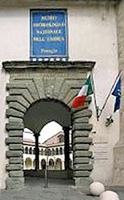
The museum was established in 1790 and moved to its current location, the Convento di San Domenico in 1962. It contains a fine collection of ancient artefacts from Perugia and the surrounding region. Its excellent website “Archeotouch” is available using the museum’s wifi, thereby transforming your smart phone or tablet into a virtual guide. (I “suck” it into my iPad using Sitesucker).
Ipogeo dei Cai Catu
A door on the right as you enter the large cloister opens into the ticket office. Steps here lead down to the room that contains the reconstruction of the Ipogeo dei Cai Catu. The steps in the corner of the cloister, under the campanile, lead to the main part of the museum.
Exhibits in the Large Cloister (Lower Level)
Mosaic (ca. 50 AD)

This black and white mosaic with a geometric design is on the north wall. It was excavated in 1918 from a Roman house in Via Fani (see Walk VI).
Inscriptions of Perusia Restituta (early 1st century AD)
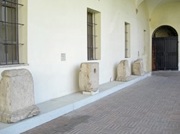
These four travertine cippi on the south wall of the entrance cloister in the Museo Archeologico all contain the same Latin inscription (CIL XI 1923):
Augusto sacr(um)/ Perusia restituta
Consecrated to Augustus by Perusia “restored”
All four are damaged and one of them was adapted at some point to serve as a fountain. They were first documented in the 16th century, by which time they seem to have been embedded in the Etruscan walls below the church of SS Annunziata, and they had probably been erected on a site outside the walls here. An altar (now lost) that was found in a similar location in the 16th century had an inscription (CIL XI 1922):
Augusto/ lucus/ sacer
This grove is sacred to Augustus
This suggests that the cippi and the altar came from a cult site dedicated to Augustus here, and that the cippi were probably used to mark the boundaries of the grove.
The inscriptions on the altars refer to ‘Perusia restituta’: Simone Sisami (referenced below, at p. 290) suggested that they were erected to celebrate the city’s return to the good graces of Augustus as Augusta Perusia. It is significant that the grove was sacred to Augustus, rather than to divus Augustus: as Sisani pointed out, this presumably implies a cult offered to Augustus before his death in 14 AD. Further, since the earliest securely-attested cult to Augustus dates 2 BC, Sisani suggested that:
-
“... we might reasonably date the cippi [and the altar] to the period after 2 BC and [thus] to the last 15 years of Augustus’ reign ...” (my translation)
Funerary Inscription (early 1st century AD)
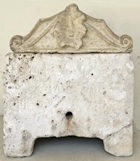
L(ucius) Proculeius A(uili) f(illius)
Titia gnatus
IIIIvir IIvir
It commemorates Lucius Proculeius, son of Aulus and Titia, who had served as quattuorvir and then duovir. The quattuorviri of Perusia were replaced by duoviri when Augustus ‘restored’ the city in some way and renamed it as Perusia Augusta. The EAGLE database (see the CIL link) dates the inscription to the period 1-14 AD).
Funerary Altar (2nd half of the 2nd century AD)
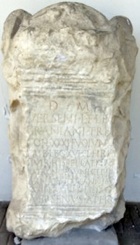
D(is) M(anibus)/ [-] Verseni L(uci) f(ili) Leṃ(onia) Graniani
tri[b(uni)]/ coh(ortis) XXXII volun[t(ariorum)]
trib(uni) leg(ionis) XVI Fl(aviae) Firm(ae)
IIvir(i) Hispellatium, patrono municipi/ Arnat(ium);
vixit annis/ XXXII, fratri piìssim[o]/ [-] Versenus Aper
From this, we learn that Versenus Granianus had been a duovir of Hispellum and a patron of Arna (now Civitella d'Arna, some 10 km east of Perugia:
-
✴The brother of Versenus Granianus is recorded as Versenus Aper Hespello (from Hispellum) in another inscription (AE 1997, 1768) that dates to 157 AD.
-
✴The brothers were probably descended from Marcus Granius, one of the earliest duoviri of Hispellum.
His membership of the Lemonia tribe also suggests an association with Hispellum. It is possible that the land on which he was buried (a few miles north of Perugia) was an enclave of the Colonia Julia Hispellum.
Inscription to the Emperor Caracalla (198 AD)
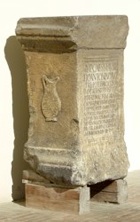
Read more:
M. Saioni (Ed.), “Invito al Museo: Percorsi, Immagini, Materiali del Museo Archeologico Nazionale dell'Umbria”, (2009 ) Perugia (available at the ticket office)
S. Sisani, “Perusia Restituta”, Bollettino della Deputazione di Storia Patria per l’Umbria, 108:1 (2011) 273-94
Proceed to the ticket office (through a door on the right as you enter the large cloister) and down to the reconstruction of the Ipogeo dei Cai Catu.
Walk around the lower cloister to the corner under the campanile and up the stairs
to reach the upper level of the large cloister.
Exhibits in the museum that are not at present on display (and those that I have yet to track down) are described on the page “Deposit”.
Return to Museums of Perugia.
Return to Walk IV.



